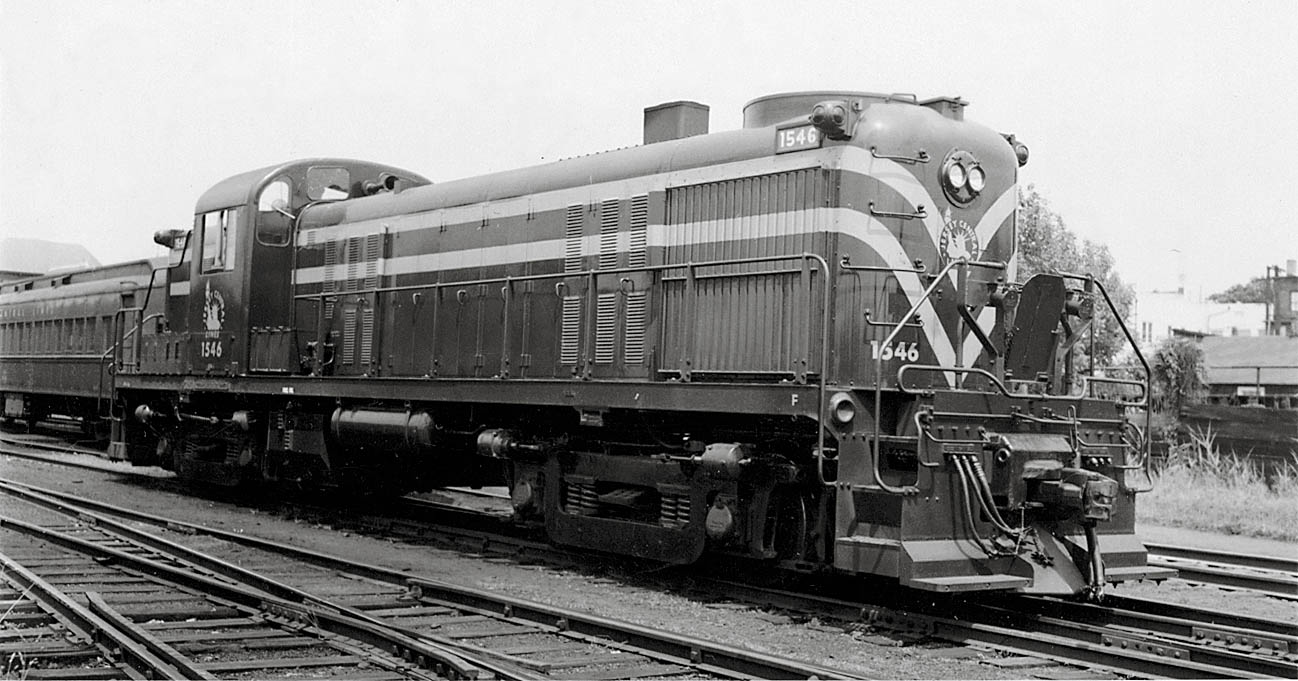A First, it’s important to note on any diesel where the little “F” is painted. That end, of course, normally is the leading end, but its real purpose is to establish for the whole crew which way is “forward” and which is “reverse” when the conductor or designated ground crewmember gives hand or radio signals to the lead unit’s engineer to move the locomotive or train.
The first “hood unit” or road-switcher, the pre-World War II Alco RS1, was designed to run long-hood forward, as were most – but not all – later Alcos and Baldwins. EMD’s postwar GP7 usually was set up short-hood forward, but the set-up was a customer option. In the GP7/GP9 era, many Eastern roads, plus the Great Northern, chose long-hood forward, but they were the minority. Some roads specified dual controls, enabling the engineer to run either way from the right side of the cab; commuter carriers such as the pictured Central Railroad of New Jersey were good examples.The lack of a wye or turning facility on a given route often required a solo engine without dual controls to run long hood first, engineer on the left. Regardless, the fireman had lookout duty, especially on his side.
A few railroads (Southern and Norfolk & Western stood out) chose dual controls but ran long-hood first by agreement with the Brotherhood of Locomotive Engineers and/or Brotherhood of Locomotive Firemen & Enginemen; the stated rationale was to provide protection for the engine crew in the event of a grade-crossing collision. (The Pennsylvania Railroad’s GG1 electrics were designed with cabs toward the center for the same reason.)
By the 1950s, firemen in diesel cabs became a hot topic, and management fought to eliminate them. The issue wasn’t settled until the gradual transition mandated by the Presidential Railroad Commission of 1960-62, created by Executive Order No. 10891 to hold hearings and to resolve the long battle as whether firemen were needed on diesel locomotives and whether their positions could be cut.
While the fireman’s position was being eliminated, new RSs and Geeps featured low short hoods. Railroads still had a second crewman in the cab (head-end brakeman or, with elimination of cabooses, the conductor on freights). In any case, the second person needed to be qualified on locations and indications of all lineside signals. On many passenger trains today, only the engineer is in the cab. – Bill Withuhn, curator emeritus, National Museum of American History, Smithsonian Institution















Mr. Smith–you are mostly correct. The “F” is indeed a FRA requirement, and it does indeed factor in when reporting defects on the locomotive; in addition, the terms “Fireman’s side” or “Engineer’s side” are also used (as long as there are not dual-controls in the cab).
However, the “F” is the absolute reference that is used by ground crews when direction of motion is requested, regardless of which way the locomotive is facing.
On the LIRR, our ALCO C-420″s and RS1&2’s were long hood forward to provide protection for the engine crew during the 60’s & 70’s.
The little “F” painted on all locomotives is an FRA requirement. It establishes the front end of the locomotive so when the crew reports a defect, such as with a brake cylinder or coupler, the mechanical department has no confusion as to where the defect is. It does not establish which way is forward and reverse when operating the locomotive.
As John mentioned, people often lump SOU and N&W engines together, but SOU engines did not have dual controls, only a “bidirectional stand” that really wasn’t all that bidirectional. The early engines were SHF, but later on only GP30s and GP35s were notable plus the SD24s, for not being LHF. NS ordered LHF GEs right up until 1989/1990s.
I suspect the GN ordered their Geeps and early SD’s long nose forward was for protection in the case of an accident. After the 1970 BN merger, I got a day clerking job on the X-GN side and met an X-NP engineer I knew. He was cussing his X-GN SD unit because he was used to short nose forward. As information, the NP paid ALCO $550 extra to set their early RS units short nose forward. I suspect it was to protect the engine crew from engine exhaust.
“A few railroads (Southern and Norfolk & Western stood out) chose dual controls but ran long-hood first……”
The Southern Railway locomotives did not have dual controls. Most, but not all, were set up as long hood front. GP-30’s and GP-35’s as well as SD-24’s and SD-35’s were short hood front. (I believe GP-7’s also were short hood front while GP-9’s were long hood front.) In actual practice Southern ran their locomotives facing whatever direction. As often as not you would be running short end first (with the engineer seated on the left side of the cab) or long end first (engineer seated on the right side). Management didn’t care as long as the tonnage got moved. Of course, you have not lived until you have operated one of the above mentioned GP-30’s, with the long end first. Now you are seated on the left side of the cab (with that long hood out in front of you) and you cannot see any of the block signals! This practice (running the locomotives facing whichever direction they happened to be in) continued into Norfolk Southern and probably still does today.
Ethan Smyre, in many ways that is true, unless it was on SP Cabforwards. Plus, until the arrival of the wide cab design, long-hood forward in truth did offer some form of protection in the event of a collision, whether with a vehicle or another train because of having most of the locomotive body in front, rather than behind the crew.
I’ve heard that crews liked long hood forward because the vision obstruction was similar to that of the steam engine they would have operated before the conversion to diesel. Is this true or just lore